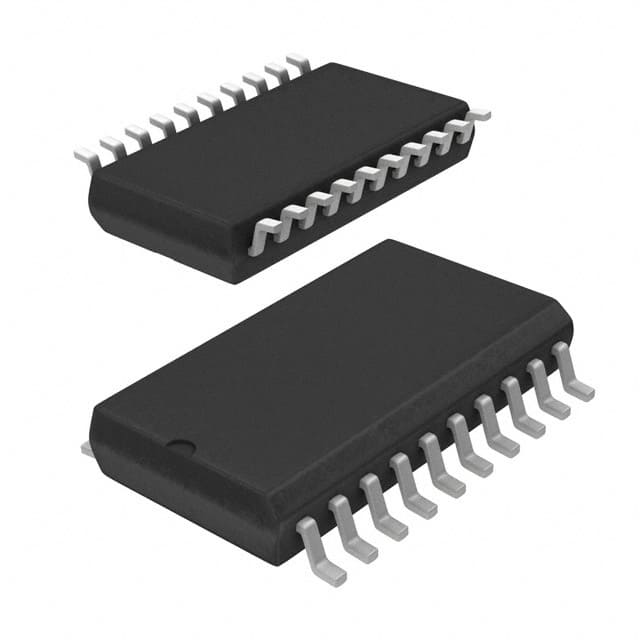Lihat spesifikasi untuk detail produk.

CD74HC245M96
Product Overview
- Category: Integrated Circuit
- Use: Level Shifter and Bus Transceiver
- Characteristics: High-Speed, CMOS Logic, 3-State Outputs
- Package: SOIC-20
- Essence: The CD74HC245M96 is a high-performance integrated circuit that provides level shifting and bus transceiver functionality. It is designed to interface between different voltage levels and bidirectional buses.
- Packaging/Quantity: The CD74HC245M96 is available in a standard SOIC-20 package and is typically sold in reels of 2500 units.
Specifications
- Supply Voltage: 2V to 6V
- Input Voltage: 0V to VCC
- Output Voltage: 0V to VCC
- Operating Temperature Range: -40°C to +85°C
- Propagation Delay: 10ns (typical)
- Output Current: ±6mA
Pin Configuration
The CD74HC245M96 has a total of 20 pins arranged as follows:
+---+--+---+
A1 --|1 +--+ 20|-- VCC
A2 --|2 19|-- B1
A3 --|3 18|-- B2
A4 --|4 17|-- B3
A5 --|5 16|-- B4
A6 --|6 15|-- B5
A7 --|7 14|-- B6
A8 --|8 13|-- B7
GND--|9 12|-- B8
OE --|10 11|-- DIR
+----------+
Functional Features
- Bidirectional Level Shifting: The CD74HC245M96 allows for bidirectional voltage level shifting between two different voltage domains.
- Bus Transceiver: It provides a convenient interface for connecting and controlling bidirectional buses.
- High-Speed Operation: The CMOS logic design enables high-speed data transmission with minimal propagation delay.
- 3-State Outputs: The outputs can be put into a high-impedance state, allowing multiple devices to share the same bus without interference.
Advantages and Disadvantages
Advantages: - Wide Supply Voltage Range: Can operate with supply voltages ranging from 2V to 6V, making it compatible with various systems. - Fast Propagation Delay: Provides quick response times for efficient data transfer. - Compact Package: The SOIC-20 package offers a small footprint, suitable for space-constrained applications.
Disadvantages: - Limited Output Current: The CD74HC245M96 has a maximum output current of ±6mA, which may not be sufficient for driving certain loads. - Temperature Limitations: The operating temperature range is limited to -40°C to +85°C, which may restrict its use in extreme environments.
Working Principles
The CD74HC245M96 operates by using CMOS technology to shift voltage levels bidirectionally. It consists of input/output buffers that allow for voltage translation between two different voltage domains. The DIR pin controls the direction of data flow, while the OE pin enables or disables the outputs. When the OE pin is high, the outputs are in a high-impedance state.
Detailed Application Field Plans
The CD74HC245M96 finds applications in various fields, including:
- Microcontroller Interfacing: It can be used to interface microcontrollers operating at different voltage levels.
- Communication Systems: The CD74HC245M96 facilitates level shifting and bus transceiver functionality in communication systems.
- Industrial Automation: It is suitable for connecting different modules and devices in industrial automation applications.
- Automotive Electronics: The IC can be utilized in automotive electronics to interface between different voltage domains.
Detailed and Complete Alternative Models
- SN74HCT245N: This is a similar level shifter and bus transceiver IC from Texas Instruments, offering comparable features and performance.
- 74LVC245A: Another alternative from NXP Semiconductors, providing bidirectional level shifting and bus transceiver capabilities.
These alternative models can be considered based on specific requirements and availability.
In conclusion, the CD74HC245M96 is a versatile integrated circuit that enables bidirectional level shifting and bus transceiver functionality. With its high-speed operation, compact package, and wide supply voltage range, it finds applications in various fields such as microcontroller interfacing, communication systems, industrial automation, and automotive electronics.
Sebutkan 10 pertanyaan dan jawaban umum terkait penerapan CD74HC245M96 dalam solusi teknis
Sure! Here are 10 common questions and answers related to the application of CD74HC245M96 in technical solutions:
Q: What is CD74HC245M96? A: CD74HC245M96 is a high-speed CMOS octal bus transceiver with 3-state outputs, commonly used for bidirectional level shifting and voltage translation.
Q: What is the operating voltage range of CD74HC245M96? A: CD74HC245M96 operates within a voltage range of 2V to 6V.
Q: How many channels does CD74HC245M96 have? A: CD74HC245M96 has 8 bidirectional channels.
Q: What is the maximum data transfer rate supported by CD74HC245M96? A: CD74HC245M96 supports a maximum data transfer rate of 80 MHz.
Q: Can CD74HC245M96 be used for level shifting between different voltage domains? A: Yes, CD74HC245M96 can be used for level shifting between different voltage domains, as long as the voltage levels are within its operating range.
Q: Does CD74HC245M96 have built-in protection features? A: No, CD74HC245M96 does not have built-in protection features. External protection components may be required depending on the application.
Q: Can CD74HC245M96 be used for bi-directional communication? A: Yes, CD74HC245M96 is designed for bidirectional data transfer and can be used for bi-directional communication.
Q: What is the output drive capability of CD74HC245M96? A: CD74HC245M96 has a typical output drive capability of ±6 mA.
Q: Can CD74HC245M96 be used in automotive applications? A: Yes, CD74HC245M96 is suitable for automotive applications as it meets the necessary standards and specifications.
Q: Are there any specific layout considerations for using CD74HC245M96? A: Yes, it is recommended to follow the layout guidelines provided in the datasheet to ensure proper performance and minimize noise coupling.
Please note that these answers are general and may vary depending on the specific application and requirements. It is always advisable to refer to the datasheet and consult with technical experts for accurate information.

